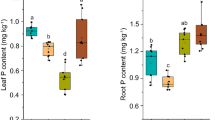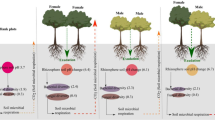Abstract
Background and aims
Lead (Pb) contamination seriously threatens agroforestry production and safety. We aim to determine the interactive influence of Pb and sexual competition on the growth performance, photosynthetic and biochemical traits, ultrastructure and phytoremediation-related parameters of males and females.
Methods
In the present study, eco-physiological responses and phytoremediation traits of Populus cathayana females and males were evaluated under interactive treatments of Pb and competition.
Results
There were significant sex-specific competition effects on biomass partition, photosynthetic activities, carbohydrate contents, nitrogen and phosphorus use efficiencies, ultrastructure and phytoremediation under Pb stress. When competition within the same sex was compared, females were more sensitive to Pb stress, while males possessed greater Pb contents, and a higher bioconcentration factor and tolerance index. Under inter-sexual competition, males alleviated competition effects through greater Pb absorption, and lower photosynthetic rates, nutrient use efficiencies and biomass accumulation. Moreover, Pb stress altered competition intensities of both sexes.
Conclusions
Sex-specific competition and neighbor effects may regulate responses and phytoremediation under heavy metal stress in dioecious plants. In the future, more attention should be paid on the effects of inter- and intra-sexual competition on dioecious species in the process of forestation and restoration of contaminated soil.





Similar content being viewed by others
References
Ahmad-Ramli MF, Cornulier T, Johnson D (2013) Partitioning of soil phosphorus regulates competition between Vaccinium vitis-idaea and Deschampsia cespitosa. Ecol Evol 3:4243–4252
Baker AJM, McGrath SP, Sideli CMD, Reeves RD (1994) The possibility of in-situ heavy metal decontamination of polluted soils using crops of metal-accumulating plants - a feasibility study. Resour Conserv Recycl 11:41–49
Bertness MD, Callaway R (1994) Positive interactions in communities. Trends Ecol Evol 9:191–193
Bloor JMG, Leadley PW, Barthes L (2008) Responses of Fraxinus excelsior seedlings to grass-induced above- and below-ground competition. Plant Ecol 194:293–304
Callaway RM, Walker L (1997) Competition and facilitation: a synthetic approach to interactions in a plant community. Ecology 78:1958–1965
Chen LH, Zhang S, Zhao HX, Korpelainen H, Li CY (2010) Sex-related adaptive responses to interaction of drought and salinity in Populus yunnanensis. Plant Cell Environ 33:1767–1778
Chen LH, Han Y, Jiang H, Korpelainen H, Li CY (2011) Nitrogen nutrient status induces sexual differences in responses to cadmium in Populus yunnanensis. J Exp Bot 62:5037–5050
Dawson TE, Ehleringer JR (1993) Gender-specific physiology, carbon isotope discrimination, and habitat distribution in boxelder, Acer negundo. Ecology 74:798–815
Deyn GB, Van der Putten WH (2005) Linking aboveground and belowground diversity. Trends Ecol Evol 20:625–633
Donaldson JR, Kruger EL, Lindroth RL (2006) Competition and resource-mediated tradeoffs between growth and defensive chemistry in trembling aspen (Populus tremuloides). New Phytol 169:561–570
Duan BL, Dong TF, Zhang XL, Zhang YB, Chen J (2014) Ecophysiological responses of two dominant subalpine tree species Betula albosinensis and Abies faxoniana to intra- and interspecific competition under elevated temperature. For Ecol Manag 323:20–27
Dudley LS (2006) Ecological correlates of secondary dimorphism in Salix glauca (Salicaceae). Am J Bot 93:1775–1783
Dybzinski R, Tilman D (2007) Resource use patterns predict long-term outcomes of plant competition for nutrients and light. Am Nat 170:305–318
Eppley SM (2006) Females make tough neighbours: sex-specific competitive effects in seedlings of a dioecious grass. Oecologia 46:549–554
Ermakov VV, Petrunina NS, Tyutikov SF, Danilova VN, Khushvakhtova SD, Degtyarev AP, Krechetova EV (2015) Concentrating metals by plants of the genus Salix and their importance for identification of Cd anomalies. Geochem Int 53:951–963
Fargione J, Brown CS, Tilman D (2003) Community assembly and invasion: an experimental test of neutral versus niche processes. Proc Natl Acad Sci U S A 100:8916–8920
Grace JB (1995) On the measurement of plant competition intensity. Ecology 76(1):305–308
Guo QX, Li JY, Zhang YX, Zhang JX, Lu DL, Korpelainen H, Li CY (2016) Species-specific competition and N fertilization regulate non-structural carbohydrate contents in two Larix species. For Ecol Manag 364:60–69
Han Y, Wang L, Zhang XL, Korpelainen H, Li CY (2013) Sexual differences in photosynthetic activity, ultrastructure and phytoremediation potential of Populus cathayana exposed to lead and drought. Tree Physiol 33:1043–1060
He J, Ma C, Ma Y, Li H, Kang J, Liu T, Polle A, Peng C, Luo ZB (2013) Cadmium tolerance in six poplar species. Environ Sci Pollut Res 20:163–174
Herrera CM (1988) Plant size, spacing patterns, and host-plant selection in Osyris quadripartita, a hemiparasitic dioecious shrub. J Ecol 76:995–1006
Hötscher M, Hay MJM (1997) Genotypic differences in physiological integration, morphological plasticity and utilization of phosphorus induced by variation in phosphate supply in Trifolium repens. J Ecol 85:341–350
Islam E, Liu D, Li T, Yang X, Jin X, Mahmood Q, Tian S, Li J (2008) Effect of Pb toxicity on leaf growth, physiology and ultrastructure in the two ecotypes of Elsholtzi aargyi. J Hazard Mater 154:914–926
Jiang H, Korpelainen H, Li CY (2013) Populus yunnanensis males adopt more efficient protective strategies than females to cope with excess zinc and acid rain. Chemosphere 91:1213–1220
Julkunen-Tiitto R (1985) Phenolic constituents in the leaves of northern willows-methods for the analysis of certain phenolics. J Agric Food Chem 33:213–217
Juvany M, Munné-Boch S (2015) Sex-related differences in stress tolerance in dioecious plants: a critical appraisal in a physiological context. J Exp Bot 66:6083–6092
Kalaji HM, Loboda T (2007) Photosystem II of barley seedlings under cadmium and lead stress. Plant Soil and. Environment 53:511–516
Kegge W, Pierik R (2010) Biogenic volatile organic compounds and plant competition. Trends Plant Sci 15:126–132
Korpelainen H (1991) Sex ratio variation and spatial segregation of the sexes in populations of Rumex acetosa and R. acetosella (Polygonaceae). Plant Syst Evol 174:183–195
Li CY, Xu G, Zang RG, Korpelainen H, Berninger F (2007) Sex-related differences in leaf morphological and physiological responses of Hippophae rhamnoides along an altitudinal gradient. Tree Physiol 27:399–406
Liancourt P, Callaway RM, Michalet R (2005) Stress tolerance and competitive response ability determine the outcome of biotic interactions. Ecology 86:1611–1618
Lichtenthaler HK (1987) Chlorophylls and carotenoids: pigments of photosynthetic biomembranes. Methods Enzymol 148:350–382
Liu X, Kozovits AR, Grams TEE, Blaschke H, Rennenberg H, Matyssek R (2004) Competition modifies effects of enhanced ozone/carbon dioxide concentrations on carbohydrate and biomass accumulation in juvenile Norway spruce and European beech. Tree Physiol 24:1045–1055
Llugany M, Tolra R, Martin SR, Poschenrieder C, Barcelo J (2013) Cadmium-induced changes in glutathione and phenolics of Thlaspi and Noccaea species differing in Cd accumulation. J Plant Nutr Soil Sci 176:851–858
Long SP, Bernacchi CJ (2003) Gas exchange measurements, what can they tell us about the underlying limitations to photosynthesis? Procedures and sources of error. J Exp Bot 54:2393–2401
Maestre FT, Callaway RM, Valladares F, Lortie CJ (2009) Refining the stress-gradient hypothesis for competition and facilitation in plant communities. J Ecol 97:199–205
Mayor JR, Wright SJ, Turner BL (2014) Species-specific responses of foliar nutrients to long-term nitrogen and phosphorus additions in a lowland tropical forest. J Ecol 102:36–44
McKane RB, Johnson LC, Shaver GR, Nadelhoffer KJ, Rastetter EB, Fry B, Giblin AE, Kielland K, Kwiatkowski BL, Laundre JA, Murray G (2002) Resource-based niches provide a basis for plant species diversity and dominance in arctic tundra. Nature 415:68–71
Millard P, Way DA (2011) Tree competition and defense against herbivores: currency matters when counting the cost. Tree Physiol 31:579–581
Miller AE, Bowman WD, Suding KN (2007) Plant uptake of inorganic and organic nitrogen: neighbor identity matters. Ecology 88:1832–1840
Mitchell AK (1998) Acclimation of Pacific yew (Taxus brevifolia) foliage to sun and shade. Tree Physiol 18:749–757
Myers JA, Kitajima K (2007) Carbohydrate storage enhances seedling shade and stress tolerance in a neotropical forest. J Ecol 95:383–395
Nanami S, Kawaguchi H, Yamakura T (2005) Sex ratio and gender dependent neighboring effects in Podocarpus nagi, a dioecious tree. Plant Ecol 177:209–222
Nicotra AB (1999) Sexually dimorphic growth in the dioecious tropical shrub, Siparuna grandiflora. Funct Ecol 13:322–331
O’Brien MJ, Leuzinger S, Philipson CD, Tay J, Hector A (2014) Drought survival of tropical tree seedlings enhanced by non-structural carbohydrate levels. Nat Clim Chang 4:710–714
Olsson T, Leverenz JW (1994) Non-uniform stomatal closure and the apparent convexity of the photosynthetic photon flux density response curve. Plant Cell Environ 17:701–710
Onyekwelu SS, Harper JL (1979) Sex ratio and niche differentiation in spinach (Spinacia oleracea L). Nature 282:609–611
Paul-Victor C, Zust T, Rees M, Kliebenstein DJ, Turnbull LA (2010) A new method for measuring relative growth rate can uncover the costs of defensive compounds in Arabidopsis thaliana. New Phytol 187:1102–1111
Prioul JL, Chartier P (1977) Partitioning of transfer and carboxylation components of intracellular resistance to photosynthetic CO2 fixation: a critical analysis of the methods used. Ann Bot 41:789–800
Qasim B, Motelica-Heino M, Bourgerie S, Gauthier A, Morabito D (2016) Rhizosphere effects of Populus euramericana Dorskamp on the mobility of Zn, Pb and Cd in contaminated technosols. J Soils Sediments 16:811–820
Renner SS, Ricklefs RE (1995) Dioecy and its correlates in the flowering plants. Am J Bot 82:596–606
Rogers SR, Eppley SM (2012) Testing the interaction between inter-sexual competition and phosphorus availability in a dioecious grass. Botany 90:704–710
Sánchez-Vilas J, Turner A, Pannell JR (2011) Sexual dimorphism in intra- and inter-specific competitive ability of the dioecious herb Mercurialis annua. Plant Biol 13:218–222
Santiago LS, Wright SJ, Harms KE, Yavitt JB, Korine C, Garcia MN, Turner BL (2012) Tropical tree seedling growth responses to nitrogen, phosphorus and potassium addition. J Ecol 100:309–316
Secchi F, Zwieniecki MA (2011) Sensing embolism in xylem vessels: the role of sucrose as a trigger for refilling. Plant Cell Environ. 34:514–524
Shahid M, Pinelli E, Pourrut B, Silvestre J, Dumat C (2011) Lead-induced genotoxicity to Vicia faba L. roots in relation with metal cell uptake and initial speciation. Ecotoxicol Environ Saf 74:78–84
Stehlik I, Friedman J, Barrett SCH (2008) Environmental influence on primary sex ratio in a dioecious plant. Proc Natl Acad Sci U S A 105:10847–10852
Sterner RW, Elser JJ (2002) Ecological stoichiometry: the biology of elements from molecules to the biosphere. Princeton University Press, Princeton
Tilman D (1982) Resource competition and community structure. Princeton University Press, Princeton
Trinder CJ, Brooker RW, Davidson H, Robinson D (2012) Dynamic trajectories of growth and nitrogen capture by competing plants. New Phytol 193:948–958
Xu X, Yang F, Xiao XW, Zhang S, Korpelainen H, Li CY (2008) Sex-specific responses of Populus cathayana to drought and elevated temperatures. Plant Cell Environ 31:850–860
Yemm EW, Willis AJ (1954) The estimation of carbohydrates in plant extracts by anthrone. Biochem J 57:508–514
Zayed A, Gowthaman S, Terry N (1998) Phytoaccumulation of trace elements by wetland plants: I. Duckweed. J Environ Qual 27:715–721
Zhang CY, Zhao XH, Gao LS, Gadow K (2009) Gender, neighboring competition and habitat effects on the stem growth in dioecious Fraxinus mandshurica trees in a northern temperate forest. Ann For Sci 812:1–9
Zhang S, Jiang H, Zhao HX, Korpelainen H, Li CY (2014) Sexually different physiological responses of Populus cathayana to nitrogen and phosphorus deficiencies. Tree Physiol 34:343–354
Acknowledgements
This work was supported by the China Postdoctoral Science Foundation (2015M570797), the Talent Program of the Mianyang Normal University (QD2015A005) and the Talent Program of the Hangzhou Normal University (2016QDL020).
Author information
Authors and Affiliations
Contributions
Juan Chen had the main responsibility for data collection, analysis and writing, Qingquan Han and Baoli Duan had a significant contribution to data collection and analysis, Helena Korpelainen had a significant contribution to the interpretation of data and manuscript preparation, and Chunyang Li (the corresponding author) had the overall responsibility for experimental design and project management.
Corresponding author
Ethics declarations
Conflict of interest
The authors declare that they have no conflicts of interest.
Additional information
Responsible Editor: Henk Schat
Rights and permissions
About this article
Cite this article
Chen, J., Han, Q., Duan, B. et al. Sex-specific competition differently regulates ecophysiological responses and phytoremediation of Populus cathayana under Pb stress. Plant Soil 421, 203–218 (2017). https://doi.org/10.1007/s11104-017-3450-3
Received:
Accepted:
Published:
Issue Date:
DOI: https://doi.org/10.1007/s11104-017-3450-3




